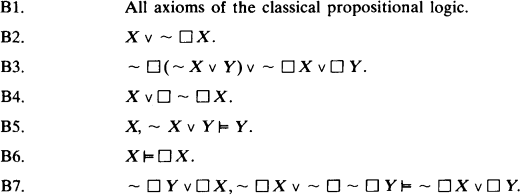Article contents
Imbedding of the quantum logic in the modal system of Brower
Published online by Cambridge University Press: 12 March 2014
Extract
We lean upon the usual variant of the logic of quantum mechanics [1]. Here the propositions correspond to the results of the quantum experiments. A beautiful essay [2] may be connected with a conservation of semantics. But we try to broaden the semantics, admitting propositions about the possibility of results of experiments. Doing so, we fulfil the old wish of W. A. Fock, who attracts our attention to the importance of the modal categories for the interpretation of the quantum theory [3].
We begin with the formal description of the modal system Br+. The alphabet contains the signs ~, ∨ and Ↄ (negation, alternative and the sign of necessity), the set V of the prepositional variables and parentheses. The rules of formation are: if A ∈ V, then A is a proposition; if X and Y are propositions, then ~ X, X ∨ Y and Ↄ X are propositions also; there are no other propositions. ℬ will design the set of all propositions.
The rules of transformation are the following:
 .
.
Here X, Y ∈ ℬ. The sign ⊨ denotes the derivability in Br+ (in one step here).
Information
- Type
- Research Article
- Information
- Copyright
- Copyright © Association for Symbolic Logic 1977
References
REFERENCES
- 17
- Cited by

